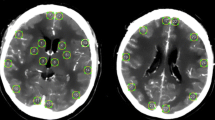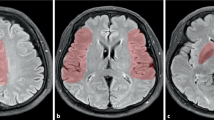Abstract
Purpose
Early infarction that occurs at the time of initial subarachnoid hemorrhage (SAH) due to rupture of an aneurysm is a poorly understood phenomenon. We investigate the frequency of early infarction using diffusion-weighted images (DWI) at the time of admission. We then discuss the pathogenesis of infarction.
Materials and methods
This study included 85 SAH patients who underwent serial DWI on admission. Early infarction detected by DWI and clinical features were investigated retrospectively.
Results
The overall incidence of DWI-detected early infarction at the time of SAH onset was 8% (7 of 85 cases). In all seven patients, early infarctions were asymptomatic on admission. Types of early infarction seen on DWI included infarcts occurring in the territory of the vessel harboring a ruptured aneurysm (solitary, three cases) and infarcts occurring outside the territory of the vessel (multiple, two cases; solitary, two cases). Six of seven patients eventually developed delayed ischemic neurological deficit (DIND) and computed tomography (CT)-detected and DWI-detected delayed extensive infarction. Four of seven patients with early infarction had an unfavorable outcome. The occurrence of DWI-detected early infarction on admission was significantly correlated with delayed angiographic vasospasm, DIND, CT-detected delayed infarction, DWI-detected delayed infarction, and unfavorable outcome.
Conclusions
In the present study, DWI-detected early infarction at the time of SAH onset was correlated with the occurrence of delayed extensive ischemic lesions. We believe that performing DWI at the time of admission is useful for evaluating the primary ischemic insult, which might play an important role in the pathogenesis of early brain injury and delayed vasospasm-related complications.



Similar content being viewed by others
References
Baldwin ME, Macdonald RL, Huo D, Novakovic RL, Goldenberg FD, Frank JI, Rosengart AJ (2004) Early vasospasm on admission angiography in patients with aneurysmal subarachnoid hemorrhage is a predictor for in-hospital complications and poor outcome. Stroke 35:2506–2511
Bederson JB, Levy AL, Ding WH, Kahn R, DiPerna CA, Jenkins AL 3rd, Vallabhajosyula P (1998) Acute vasoconstriction after subarachnoid hemorrhage. Neurosurgery 42:352–360, discussion 360–352
Bevan JA, Bevan RD, Walters CL, Wellman T (1998) Functional changes in human pial arteries (300 to 900 micrometer ID] within 48 hours of aneurysmal subarachnoid hemorrhage. Stroke 29:2575–2579
Busch E, Beaulieu C, de Crespigny A, Moseley ME (1998) Diffusion MR imaging during acute subarachnoid hemorrhage in rats. Stroke 29:2155–2161
Cahill J, Calvert JW, Zhang JH (2006) Mechanisms of early brain injury after subarachnoid hemorrhage. J Cereb Blood Flow Metab 26:1341–1353
Claassen J, Carhuapoma JR, Kreiter KT, Du EY, Connolly ES, Mayer SA (2002) Global cerebral edema after subarachnoid hemorrhage: frequency, predictors, and impact on outcome. Stroke 33:1225–1232
Denton IC, Robertson JT, Dugdale M (1971) An assessment of early platelet activity in experimental subarachnoid hemorrhage and middle cerebral artery thrombosis in the cat. Stroke 2:268–272
Drake CG (1988) Report of World Federation of Neurological Surgeons Committee on a universal subarachnoid hemorrhage grading scale. J Neurosurg 68:985–986
Dreier JP, Ebert N, Priller J, Megow D, Lindauer U, Klee R, Reuter U, Imai Y, Einhaupl KM, Victorov I, Dirnagl U (2000) Products of hemolysis in the subarachnoid space inducing spreading ischemia in the cortex and focal necrosis in rats: a model for delayed ischemic neurological deficits after subarachnoid hemorrhage? J Neurosurg 93:658–666
Favrole P, Guichard JP, Crassard I, Bousser MG, Chabriat H (2004) Diffusion-weighted imaging of intravascular clots in cerebral venous thrombosis. Stroke 35:99–103
Fisher CM, Kistler JP, Davis JM (1980) Relation of cerebral vasospasm to subarachnoid hemorrhage visualized by computerized tomographic scanning. Neurosurgery 6:1–9
Jakubowski J, Bell BA, Symon L, Zawirski MB, Francis DM (1982) A primate model of subarachnoid hemorrhage: change in regional cerebral blood flow, autoregulation carbon dioxide reactivity, and central conduction time. Stroke 13:601–611
Jennett B, Bond M (1975) Assessment of outcome after severe brain damage. Lancet 1:480–484
Kivisaari RP, Salonen O, Ohman J (2000) Basal brain injury in aneurysm surgery. Neurosurgery 46:1070–1074, discussion 1074–1076
Kusaka G, Ishikawa M, Nanda A, Granger DN, Zhang JH (2004) Signaling pathways for early brain injury after subarachnoid hemorrhage. J Cereb Blood Flow Metab 24:916–925
Naidech AM, Drescher J, Tamul P, Shaibani A, Batjer HH, Alberts MJ (2006) Acute physiological derangement is associated with early radiographic cerebral infarction after subarachnoid haemorrhage. J Neurol Neurosurg Psychiatry 77:1340–1344
Ohkuma H, Manabe H, Tanaka M, Suzuki S (2000) Impact of cerebral microcirculatory changes on cerebral blood flow during cerebral vasospasm after aneurysmal subarachnoid hemorrhage. Stroke 31:1621–1627
Ostrowski RP, Colohan AR, Zhang JH (2006) Molecular mechanisms of early brain injury after subarachnoid hemorrhage. Neurol Res 28:399–414
Schmidt JM, Rincon F, Fernandez A, Resor C, Kowalski RG, Claassen J, Connolly ES, Fitzsimmons BF, Mayer SA (2007) Cerebral infarction associated with acute subarachnoid hemorrhage. Neurocrit Care 7:10–17
Sehba FA, Bederson JB (2006) Mechanisms of acute brain injury after subarachnoid hemorrhage. Neurol Res 28:381–398
Sehba FA, Mostafa G, Friedrich V Jr, Bederson JB (2005) Acute microvascular platelet aggregation after subarachnoid hemorrhage. J Neurosurg 102:1094–1100
Shimoda M (1993) Complications of hypervolemic therapy. J Neurosurg 79:798–801
Shimoda M, Oda S, Tsugane R, Sato O (1993) Intracranial complications of hypervolemic therapy in patients with a delayed ischemic deficit attributed to vasospasm. J Neurosurg 78:423–429
Uhl E, Lehmberg J, Steiger HJ, Messmer K (2003) Intraoperative detection of early microvasospasm in patients with subarachnoid hemorrhage by using orthogonal polarization spectral imaging. Neurosurgery 52:1307–1315, disacussion 1315–1307
van den Bergh WM, Zuur JK, Kamerling NA, van Asseldonk JT, Rinkel GJ, Tulleken CA, Nicolay K (2002) Role of magnesium in the reduction of ischemic depolarization and lesion volume after experimental subarachnoid hemorrhage. J Neurosurg 97:416–422
Acknowledgments
We wish to thank Dr. Hiroshi Oba of the Department of Radiology at Teikyo University for his useful and insightful discussions on the MRI findings that evolved from this study.
Disclosure
The authors report no conflict of interest concerning the materials or methods used in this study or the findings specified in this paper.
Author information
Authors and Affiliations
Corresponding author
Rights and permissions
About this article
Cite this article
Shimoda, M., Hoshikawa, K., Shiramizu, H. et al. Early infarction detected by diffusion-weighted imaging in patients with subarachnoid hemorrhage. Acta Neurochir 152, 1197–1205 (2010). https://doi.org/10.1007/s00701-010-0640-7
Received:
Accepted:
Published:
Issue Date:
DOI: https://doi.org/10.1007/s00701-010-0640-7




